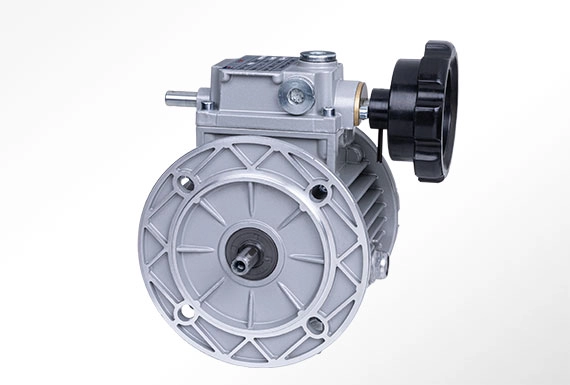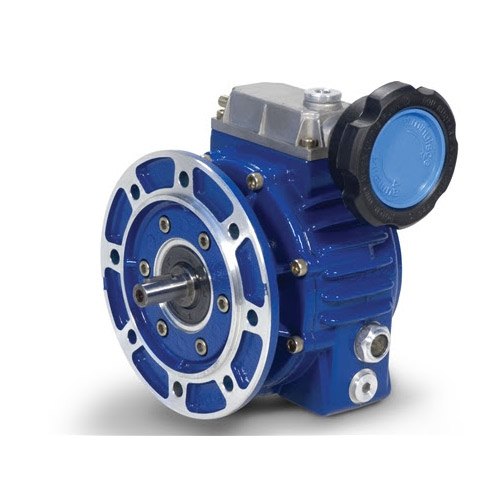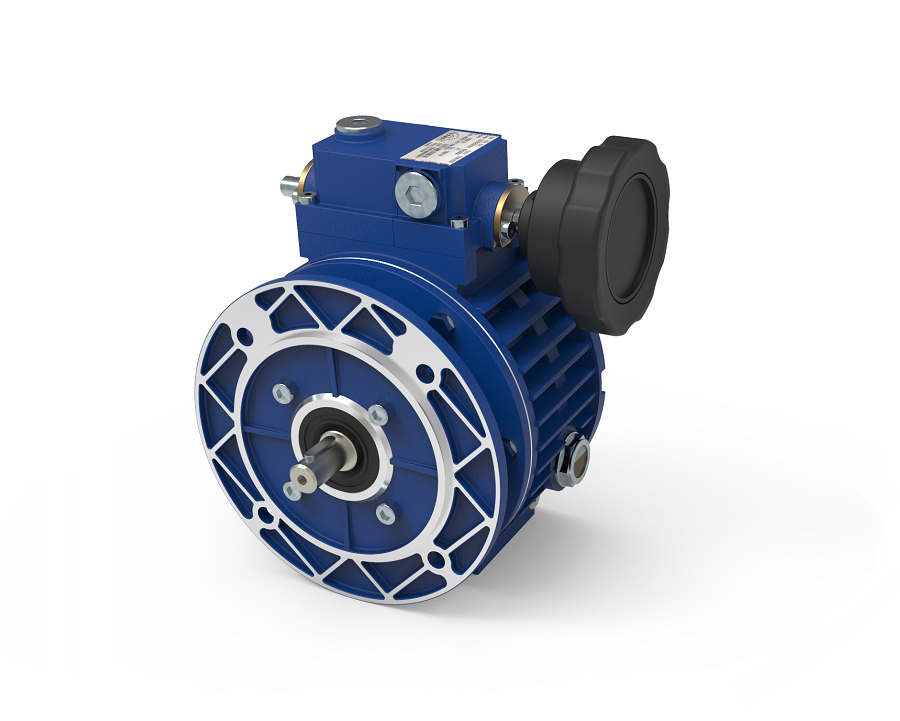Product Description
JWB Series Speed Variator
1. Features:
JWB-X type
- Sizes: ≥04
- Power up to 1.5 kW or more
- Cases in RAL 5571 blue cast iron
- Shafts: case hardened and tempered steel.
- Internal components: heat-treated steel
- Output speed with 4 pole(1400r/min) motors: 2-10r/min;4.7-23.5r/min;15-75r/min;20-100r/min, 28-140r/min, 30-150r/min;40-200r/min;60-300r/min;80-400r/min;100-500r/min;190-950r/min.
- Output Torque value max 1002Nm
- Silent, vibration-free running
- Bidirectional rotation
- Control handwheel positionable on either side
- Slipping speed to max load at 5%
- Regulation sensibility: 0,5 rpm
- Painted with blue epoxy-polyester powder
JWB-X B type
- Sizes:01,02,03 and 04
- Power up to 1.5 kW or less
- Cases in die-cast aluminium alloy
- Shafts: case hardened and tempered steel.
- Internal components: heat-treated steel
- Output speed with 4 pole(1400r/min) motors: 2r/min-20r/min;4.7r/min-23.5r/min;6.5-32.5r/min, 8-40r/min, 9-45r/min, 13-65r/min, 15r/min-75r/min;18-90r/min, 25-125r/min, 28r/min-140r/min;40r/min-200r/min;60r/min-300r/min;80r/min-400r/min;100r/min-500r/min;190r/min-950r/min.
- Output Torque value max 795 Nm
- Silent, vibration-free running
- Bidirectional rotation
- Control hand wheel positionable on either side
- Slipping speed to max load at 5%
- Regulation sensibility: 0,5 rpm
- Painted with blue epoxy-polyester powder
2. Technical parameters
| Type | Output Torque | Output Shaft Dia. | Output Speed Range | 2rpm-950rpm | |
| SWB01 | 2.6-1.6N.m | φ11 | Applicable Motor Power | 0.18kW-7.5kW | |
| SWB02 | 258-1.8N.m | φ14,φ24,φ28,φ32 | |||
| SWB03 | 426-4N.m | φ24,φ28,φ38 | Input Options | With Inline AC Motor | |
| SWB04 | 795-8N.m | φ28,φ38,φ42 | With IEC Motor | ||
| SWB05 | 535-16N.m | φ38,φ48,φ55 | With Input Shaft | ||
| SWB06 | 1002-40N.m | φ42,φ55,φ70 | With Input Flange | ||
About Us
ZheJiang CHINAMFG Drive Co.,Ltd,the predecessor was a state-owned military mould enterprise, was established in 1965. CHINAMFG specializes in the complete power transmission solution for high-end equipment manufacturing industries based on the aim of “Platform Product, Application Design and Professional Service”.
CHINAMFG have a strong technical force with over 350 employees at present, including over 30 engineering technicians, 30 quality inspectors, covering an area of 80000 square CHINAMFG and kinds of advanced processing machines and testing equipments. We have a good foundation for the industry application development and service of high-end speed reducers & variators owning to the provincial engineering technology research center,the lab of gear speed reducers, and the base of modern R&D.
Our Team
Quality Control
Quality:Insist on Improvement,Strive for Excellence With the development of equipment manufacturing indurstry,customer never satirsfy with the current quality of our products,on the contrary,wcreate the value of quality.
Quality policy:to enhance the overall level in the field of power transmission
Quality View:Continuous Improvement , pursuit of excellence
Quality Philosophy:Quality creates value
3. Incoming Quality Control
To establish the AQL acceptable level of incoming material control, to provide the material for the whole inspection, sampling, immunity. On the acceptance of qualified products to warehousing, substandard goods to take return, check, rework, rework inspection; responsible for tracking bad, to monitor the supplier to take corrective
measures to prevent recurrence.
4. Process Quality Control
The manufacturing site of the first examination, inspection and final inspection, sampling according to the requirements of some projects, judging the quality change trend;
found abnormal phenomenon of manufacturing, and supervise the production department to improve, eliminate the abnormal phenomenon or state.
5. FQC(Final QC)
After the manufacturing department will complete the product, stand in the customer’s position on the finished product quality verification, in order to ensure the quality of
customer expectations and needs.
6. OQC(Outgoing QC)
After the product sample inspection to determine the qualified, allowing storage, but when the finished product from the warehouse before the formal delivery of the goods, there is a check, this is called the shipment inspection.Check content:In the warehouse storage and transfer status to confirm, while confirming the delivery of the
product is a product inspection to determine the qualified products.
7. Certification.
Packing
Delivery
/* January 22, 2571 19:08:37 */!function(){function s(e,r){var a,o={};try{e&&e.split(“,”).forEach(function(e,t){e&&(a=e.match(/(.*?):(.*)$/))&&1
| Application: | Motor, Agricultural Machinery, Ceramic |
|---|---|
| Hardness: | Hardened Tooth Surface |
| Installation: | Vertical or Horizotal Type |
| Layout: | Coaxial |
| Gear Shape: | Planetary Conedisk Friction Type |
| Step: | Stepless |
| Customization: |
Available
|
|
|---|

What role do variators play in enhancing fuel efficiency in vehicles and machinery?
Variators, particularly those used in vehicles and machinery equipped with continuously variable transmissions (CVTs), play a crucial role in enhancing fuel efficiency. By optimizing the power delivery and enabling the engine to operate more efficiently, variators contribute to reducing fuel consumption and improving overall energy efficiency. Here’s a detailed explanation of the role variators play in enhancing fuel efficiency:
1. Continuous Adjustment of Gear Ratio:
Variators in CVTs allow for the continuous adjustment of the gear ratio within their operating range. This means that the engine can operate at the most efficient speed for a given driving condition. By continuously optimizing the gear ratio based on the vehicle’s speed and load, variators enable the engine to stay within its optimal power band, where fuel efficiency is highest. This continuous adjustment ensures that the engine operates at the most efficient RPM (revolutions per minute) for a given speed, resulting in improved fuel efficiency.
2. Elimination of Inefficient Gear Shifts:
Traditional transmissions with discrete gear ratios require frequent gear shifts during acceleration or deceleration. These gear shifts can lead to inefficient engine operation and increased fuel consumption. In contrast, variators in CVTs eliminate the need for gear shifts altogether. The smooth and continuous adjustment of the gear ratio provided by variators ensures that the engine can maintain a consistent and optimal speed, even during changes in vehicle speed. This elimination of inefficient gear shifts helps to improve fuel efficiency by maintaining the engine within its efficient operating range.
3. Precise Engine Control:
Variators enable precise control of the engine speed, allowing for finer adjustments to match the desired vehicle speed. This precise engine control ensures that the engine operates within its most efficient range. Variators continuously optimize the gear ratio based on factors such as throttle input and vehicle speed, ensuring that the engine operates at the optimal RPM for the given driving conditions. By fine-tuning the engine speed, variators help to minimize unnecessary fuel consumption and maximize fuel efficiency.
4. Adaptive Power Delivery:
Modern variators in CVTs often feature advanced control systems that adapt the power delivery to match the driver’s demands and the road conditions. These control systems monitor various parameters, such as throttle input, vehicle speed, and engine load, and adjust the gear ratio accordingly. This adaptive power delivery ensures that the engine operates efficiently in real-time, optimizing fuel consumption. By adjusting the gear ratio based on the specific driving conditions, variators contribute to improved fuel efficiency by delivering the right amount of power for the desired performance.
5. Optimal Use of Engine Torque:
Variators facilitate optimal use of the engine’s torque characteristics. They can be designed to provide a wide range of gear ratios, allowing the engine to operate at the most efficient torque levels for a given speed. By utilizing the available engine torque effectively, variators help to reduce the strain on the engine and improve fuel efficiency. This optimal use of engine torque ensures that the engine doesn’t have to work harder than necessary, resulting in reduced fuel consumption.
6. Energy Recovery and Regeneration:
Some variators in hybrid vehicles or machinery configurations are designed to incorporate energy recovery and regeneration mechanisms. These systems capture and store energy that would otherwise be wasted during deceleration or braking. By converting the kinetic energy into electrical energy and storing it in a battery or capacitor, the energy can be reused to power the vehicle or machinery during acceleration. This energy recovery and regeneration feature helps to improve overall energy efficiency and reduce fuel consumption.
In summary, variators, especially in vehicles and machinery equipped with CVTs, play a crucial role in enhancing fuel efficiency. They achieve this by providing continuous adjustment of the gear ratio, eliminating inefficient gear shifts, enabling precise engine control, facilitating adaptive power delivery, optimizing the use of engine torque, and incorporating energy recovery and regeneration systems. By optimizing power delivery and engine operation, variators contribute to reduced fuel consumption, lower emissions, and improved overall energy efficiency in vehicles and machinery.

How do variators contribute to the adaptability and versatility of machinery in different settings?
Variators play a significant role in enhancing the adaptability and versatility of machinery across various settings. Their unique design and functionality offer several benefits that enable machinery to perform effectively in diverse environments. Here’s a detailed explanation of how variators contribute to adaptability and versatility:
1. Variable Speed Control:
One of the key features of variators is their ability to provide variable speed control. By adjusting the gear ratio continuously, variators allow machinery to operate at different speeds, optimizing performance based on specific requirements. This adaptability in speed control enables machinery to adapt to different tasks, environments, and operating conditions, making them versatile in handling a wide range of applications.
2. Smooth and Seamless Transitions:
Variators offer smooth and seamless transitions between different gear ratios. Unlike traditional transmissions with fixed gear steps, variators eliminate the need for manual gear shifting, resulting in uninterrupted power delivery. This smooth transition allows machinery to adapt rapidly to changing loads, terrain, or operational demands, ensuring consistent performance and minimizing downtime.
3. Enhanced Torque and Power Distribution:
With variators, machinery can achieve enhanced torque and power distribution. By continuously adjusting the gear ratio, variators optimize the power transfer from the source (e.g., engine or motor) to the driven components. This adaptability in torque and power distribution enables machinery to handle varying loads and tasks efficiently, improving productivity and versatility across different settings.
4. Ability to Handle Variable Loads:
Variators excel in handling variable loads, which is crucial in many applications. Machinery often encounters situations where the load fluctuates due to changing materials, processes, or external factors. Variators can dynamically adjust the gear ratio to match the load requirements, ensuring optimal performance without straining the machinery. This adaptability to variable loads enhances the versatility of machinery in different settings.
5. Flexible Power Band:
Variators offer a flexible power band, allowing machinery to operate within its most efficient range. By continuously adjusting the gear ratio, variators enable the machinery to maintain the engine or motor speed at its optimal level, maximizing power output while conserving energy. This adaptability to the power band enhances the efficiency and adaptability of machinery across various settings.
6. Customizable Performance:
Variators often provide options for performance customization. They may include adjustable parameters or settings that allow operators to fine-tune the machinery’s behavior based on specific requirements. This customization capability enhances the adaptability of machinery, enabling it to be optimized for different tasks, environments, or operator preferences.
7. Integration with Advanced Control Systems:
Variators can seamlessly integrate with advanced control systems, such as electronic control units (ECUs) or programmable logic controllers (PLCs). This integration enables precise control and monitoring of the variator’s operation, allowing for adaptive and intelligent responses to changing conditions. By leveraging advanced control systems, variators enhance the adaptability and versatility of machinery by enabling features like automated performance adjustments, load sensing, and fault diagnostics.
In summary, variators contribute significantly to the adaptability and versatility of machinery in different settings. Their variable speed control, smooth transitions, enhanced torque and power distribution, ability to handle variable loads, flexible power band, customizable performance, and integration with advanced control systems all work together to enable machinery to adapt to diverse tasks, environments, and operating conditions. This adaptability and versatility enhance the machinery’s performance, productivity, efficiency, and overall utility across various settings.

Can you describe the benefits of using a variator in terms of efficiency and performance?
Using a variator in various applications can offer significant benefits in terms of efficiency and performance. The ability to continuously adjust the gear ratio and optimize engine RPM contributes to improved fuel economy, smoother power delivery, and enhanced overall performance. Here’s a detailed explanation of the benefits of using a variator:
1. Improved Fuel Efficiency:
A variator allows for precise control of the gear ratio, enabling the engine to operate within its optimal RPM range. By continuously adjusting the gear ratio to match the driving conditions, the engine can maintain an efficient power output. This optimized engine RPM helps to reduce fuel consumption and improve overall fuel efficiency. Variators are particularly beneficial in situations that involve frequent speed changes or stop-and-go traffic, where traditional gear systems may be less efficient.
2. Smoother Power Delivery:
Traditional gear systems have discrete gear ratios, resulting in noticeable gear shifts when changing gears. In contrast, a variator provides stepless gear shifts, allowing for a smooth and seamless power delivery. The continuous adjustment of the gear ratio ensures that the engine operates at the most suitable RPM for the current driving conditions, resulting in a smoother acceleration and a more refined driving experience.
3. Optimal Performance:
A variator enables the engine to operate within its optimal power band. By continuously varying the gear ratio, the variator keeps the engine RPM at an ideal level, maximizing power output and torque delivery. This translates into improved performance, whether it’s for quick acceleration, high-speed cruising, or towing heavy loads. The ability to maintain optimal performance across a wide range of driving conditions is a significant advantage of using a variator.
4. Adaptability to Driving Conditions:
A variator allows for seamless adaptation to different driving conditions. It can adjust the gear ratio based on factors such as vehicle speed, throttle input, and load requirements. This adaptability ensures that the engine operates efficiently and delivers the appropriate power for specific driving situations. Whether it’s accelerating from a standstill, maintaining a constant speed, or climbing steep inclines, the variator can optimize the gear ratio to suit the demands of the moment.
5. Reduced Wear and Tear:
Due to the smooth and continuous power delivery, variators help to reduce wear and tear on various components of the drivetrain. The absence of abrupt gear shifts and the ability to maintain optimal engine RPM contribute to reduced stress on the engine, transmission, and other driveline components. This can result in increased longevity and reliability of the vehicle or machinery.
6. Enhanced Driving Comfort:
The smooth and seamless power delivery provided by a variator contributes to enhanced driving comfort. The absence of gear shifts and the ability to maintain the engine RPM in the optimal range reduce vibrations, noise, and harshness. This leads to a more refined and enjoyable driving experience, particularly in urban driving conditions or during long-distance journeys.
In summary, using a variator in various applications offers benefits in terms of improved fuel efficiency, smoother power delivery, optimal performance, adaptability to driving conditions, reduced wear and tear, and enhanced driving comfort. These advantages make variators a desirable choice for achieving greater efficiency and performance in vehicles and machinery.


editor by CX 2024-03-05